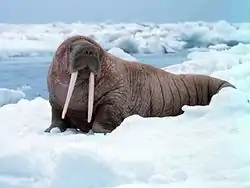海象
Chinese
| ocean; sea | shape; form; appearance; elephant; image under a map (math.) | ||
|---|---|---|---|
| simp. and trad. (海象) |
海 | 象 | |
Pronunciation
Japanese
Etymology 1

| Kanji in this term | |
|---|---|
| 海 | 象 |
| Grade: 2 | Grade: 4 |
| Irregular | |
Borrowed from Russian сивуч (sivuč, “Steller sea lion”).[1][2][3][4][5]
The kanji are jukujikun (熟字訓), from Middle Chinese 海象. See kaizō below.
Pronunciation
Usage notes
As with many terms that name organisms, this term is often spelled in katakana, especially in biological contexts, as セイウチ. Not to be confused with 象海豹 (zō azarashi, “elephant seal”).
Etymology 2
| Kanji in this term | |
|---|---|
| 海 | 象 |
| かい Grade: 2 |
ぞう Grade: 4 |
| on’yomi | |
/kaizau/ → /kaizɔː/ → /kaizoː/
From Middle Chinese 海象 (xojX zjangX, literally “sea elephant”). Compare Cantonese 海象 (hoi2 zoeng6), Vietnamese hải tượng.
The goon reading, so likely the initial borrowing.
Usage notes
This reading is much less common than seiuchi.
Etymology 3
| Kanji in this term | |
|---|---|
| 海 | 象 |
| かい Grade: 2 |
しょう Grade: 4 |
| on’yomi | |
/kaiɕau/ → /kaiɕɔː/ → /kaiɕoː/
From Middle Chinese 海象 (xojX zjangX, literally “sea + phenomenon”). Alternatively, may have been coined in Japan as a compound of Middle Chinese-derived roots.
The kan'on reading, so likely either a later borrowing, or a later innovation in Japan.
References
- 1988, 国語大辞典(新装版) (Kokugo Dai Jiten, Revised Edition) (in Japanese), Tōkyō: Shogakukan
- 1995, 大辞泉 (Daijisen) (in Japanese), Tōkyō: Shogakukan, →ISBN
- 1998, 広辞苑 (Kōjien), Fifth Edition (in Japanese), Tōkyō: Iwanami Shoten, →ISBN
- 2006, 大辞林 (Daijirin), Third Edition (in Japanese), Tōkyō: Sanseidō, →ISBN
- 1997, 新明解国語辞典 (Shin Meikai Kokugo Jiten), Fifth Edition (in Japanese), Tōkyō: Sanseidō, →ISBN